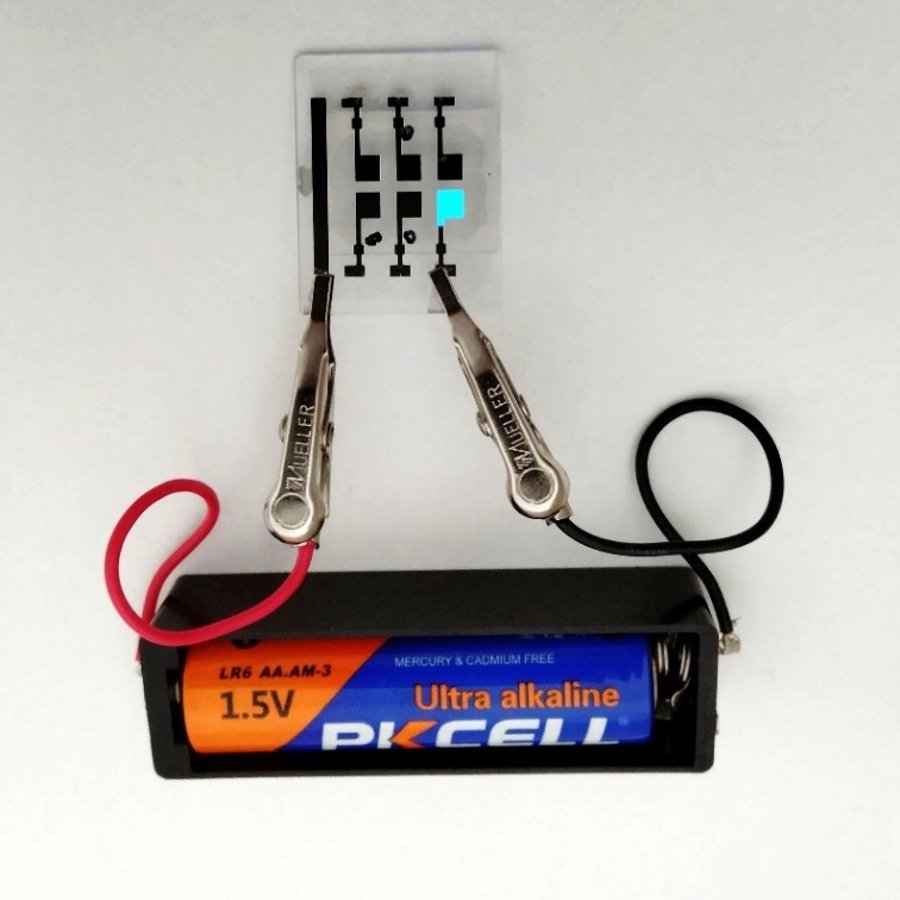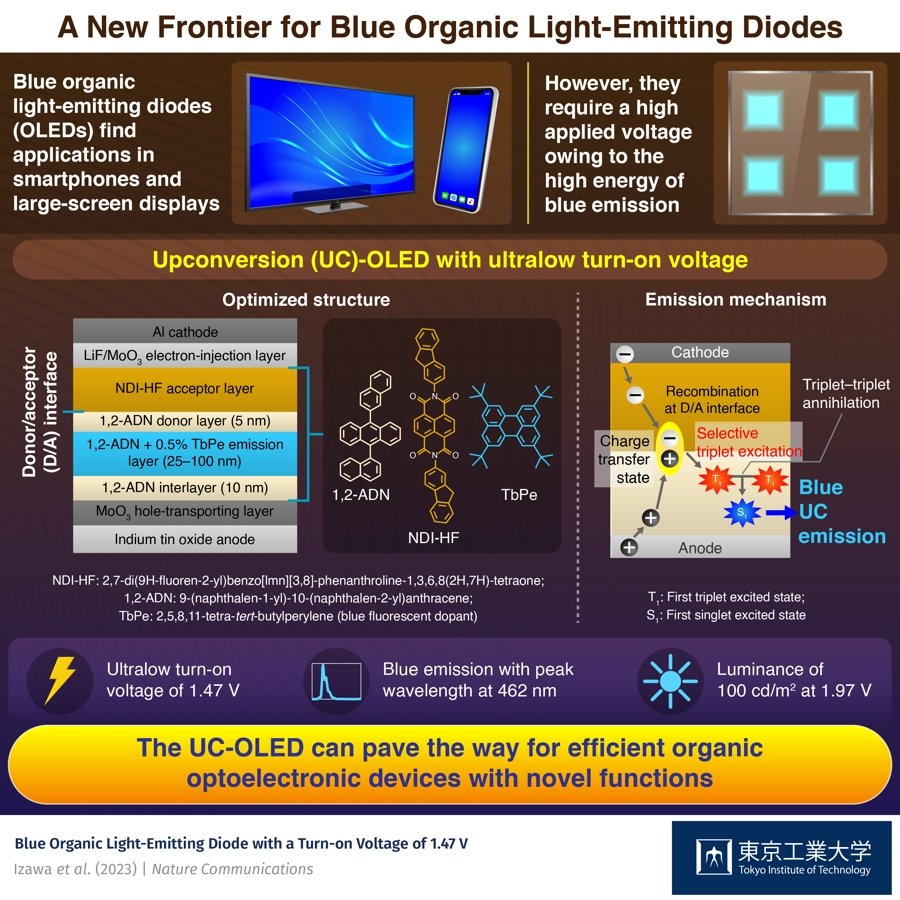(Tokyo, September 20) An upconversion organic light-emitting diode (OLED) based on a typical blue-fluorescence emitter achieves emission at an ultralow turn-on voltage of 1.47 V, as demonstrated by researchers from Tokyo Tech. Their technology circumvents the traditional high voltage requirement for blue OLEDs, leading to potential advancements in commercial smartphone and large screen displays.

Figure 1. Lighting up a blue organic LED with a single AA battery
Blue light is vital for light-emitting devices, lighting applications, as well as smartphone screens and large screen displays. However, it is challenging to develop efficient blue organic light-emitting diodes (OLEDs) owing to the high applied voltage required for their function. Conventional blue OLEDs typically require around 4 V for a luminance of 100 cd/m2; this is higher than the industrial target of 3.7 V—the voltage of lithium-ion batteries commonly used in smartphones. Therefore, there is an urgent need to develop novel blue OLEDs that can operate at lower voltages.
In this regard, Associate Professor Seiichiro Izawa from Tokyo Institute of Technology and Osaka University, collaborated with researchers from University of Toyama, Shizuoka University, and the Institute for Molecular Science has recently presented a novel OLED device with a remarkable ultralow turn-on voltage of 1.47 V for blue emission and a peak wavelength at 462 nm (2.68 eV) (as shown in Figure 1). Their work will be published in Nature Communications.
The choice of materials used in this OLED significantly influences its turn-on voltage. The device utilizes NDI-HF (2,7-di(9H-fluoren-2-yl)benzo[lmn][3,8]-phenanthroline-1,3,6,8(2H,7H)-tetraone) as the acceptor, 1,2-ADN (9-(naphthalen-1-yl)-10-(naphthalen-2-yl)anthracene) as the donor, and TbPe (2,5,8,11-tetra-tert-butylperylene) as the fluorescent dopant. This OLED operates via a mechanism called upconversion (UC). Herein, holes and electrons are injected into donor (emitter) and acceptor (electron transport) layers, respectively. They recombine at the donor/acceptor (D/A) interface to form a charge transfer (CT) state. Dr. Izawa points out: “The intermolecular interactions at the D/A interface play a significant role in CT state formation, with stronger interactions yielding superior results.”
Subsequently, the energy of the CT state is selectively transferred to the low-energy first triplet excited states of the emitter, which results in blue light emission through the formation of a high-energy first singlet excited state by triplet-triplet annihilation (TTA). “As the energy of the CT state is much lower than the emitter's bandgap energy, the UC mechanism with TTA significantly decreases the applied voltage required for exciting the emitter. As a result, this UC-OLED reaches a luminance of 100 cd/m2, equivalent to that of a commercial display, at just 1.97 V,” explains Dr. Izawa.
In effect, this study efficiently produces a novel OLED, with blue light emission at an ultralow turn-on voltage, using a typical fluorescent emitter widely utilized in commercial displays, thus marking a significant step toward meeting the commercial requirements for blue OLEDs. It emphasizes the importance of optimizing the design of the D/A interface for controlling excitonic processes and holds promise not only for OLEDs but also for organic photovoltaics and other organic electronic devices.
Let us hope that this technology gets commercialized soon!
Reference
Authors: Seiichiro Izawa1,2,3,*, Masahiro Morimoto4 , Keisuke Fujimoto5, Koki Banno5, Yutaka Majima1, Masaki Takahashi5, Shigeki Naka4, and Masahiro Hiramoto6
Title: Blue Organic Light-Emitting Diode with a Turn-on Voltage of 1.47 V
Journal: Nature Communications
DOI: 10.1038/s41467-023-41208-7
Affiliations:
1Laboratory for Materials and Structures, Institute of Innovative Research, Tokyo Institute of Technology
2Joining and Welding Research Institute, Osaka University
3Precursory Research for Embryonic Science and Technology (PRESTO), Japan Science and Technology Agency (JST)
4Academic Assembly Faculty of Engineering, University of Toyama
5Department of Applied Chemistry, Faculty of Engineering, Shizuoka University
6Institute for Molecular Science
*Corresponding authors’ email: izawa.s.ac@m.titech.ac.jp (S.I.)
Infographic

About Tokyo Institute of Technology
Tokyo Tech stands at the forefront of research and higher education as the leading university for science and technology in Japan. Tokyo Tech researchers excel in fields ranging from materials science to biology, computer science, and physics. Founded in 1881, Tokyo Tech hosts over 10,000 undergraduate and graduate students per year, who develop into scientific leaders and some of the most sought-after engineers in industry. Embodying the Japanese philosophy of “monotsukuri,” meaning “technical ingenuity and innovation,” the Tokyo Tech community strives to contribute to society through high-impact research.
https://www.titech.ac.jp/english/
About Osaka University
Osaka University was founded in 1931 as one of the seven imperial universities of Japan and is now one of Japan's leading comprehensive universities with a broad disciplinary spectrum. This strength is coupled with a singular drive for innovation that extends throughout the scientific process, from fundamental research to the creation of applied technology with positive economic impacts. Its commitment to innovation has been recognized in Japan and around the world, being named Japan's most innovative university in 2015 (Reuters 2015 Top 100) and one of the most innovative institutions in the world in 2017 (Innovative Universities and the Nature Index Innovation 2017). Now, Osaka University is leveraging its role as a Designated National University Corporation selected by the Ministry of Education, Culture, Sports, Science and Technology to contribute to innovation for human welfare, sustainable development of society, and social transformation.
https://resou.osaka-u.ac.jp/en


